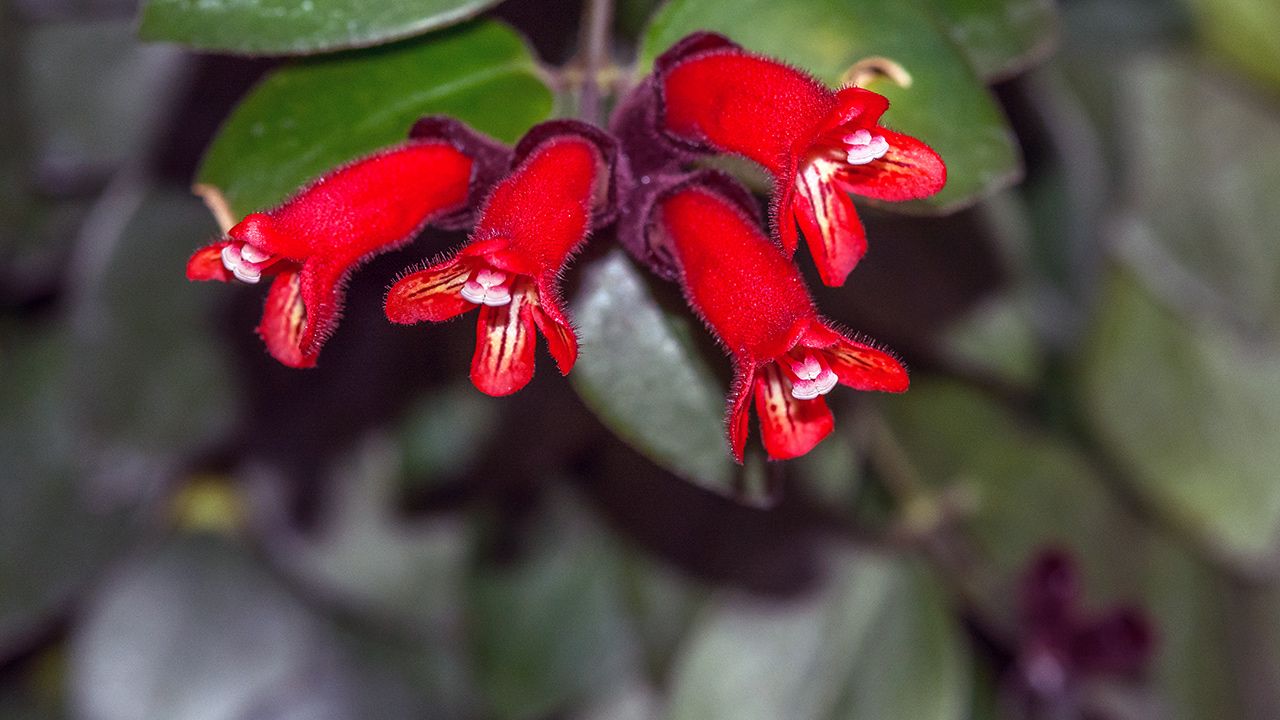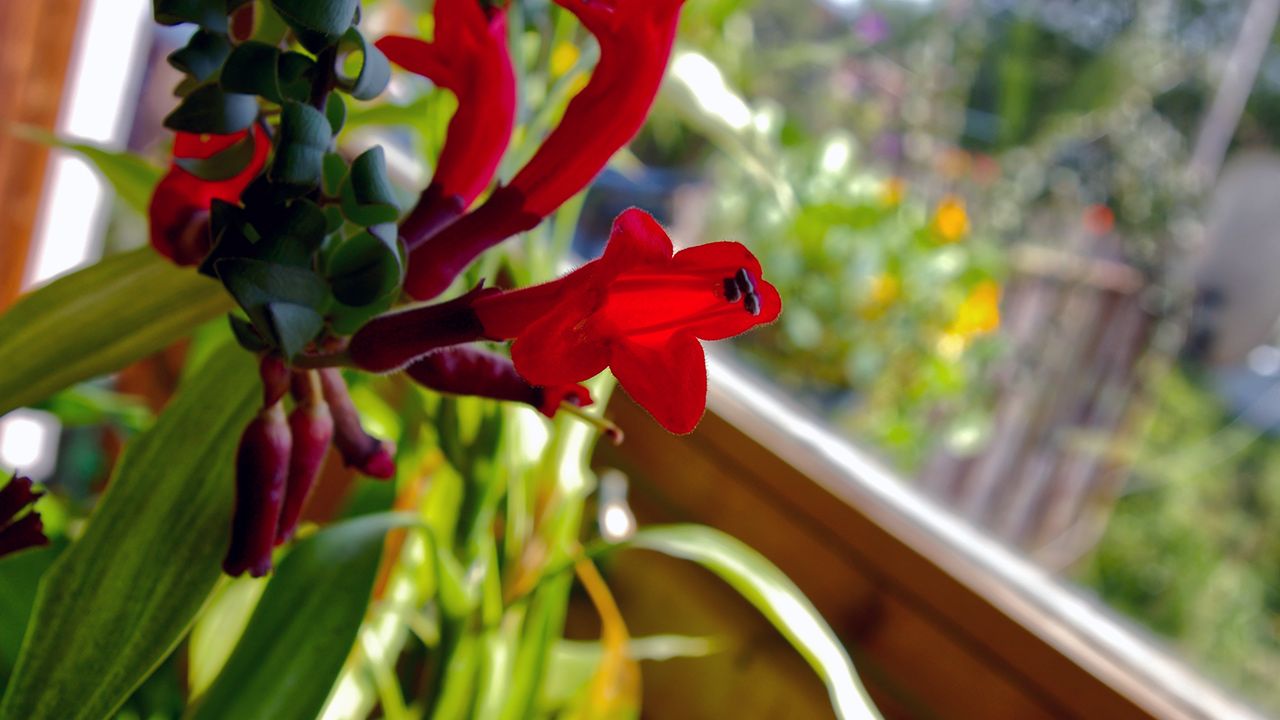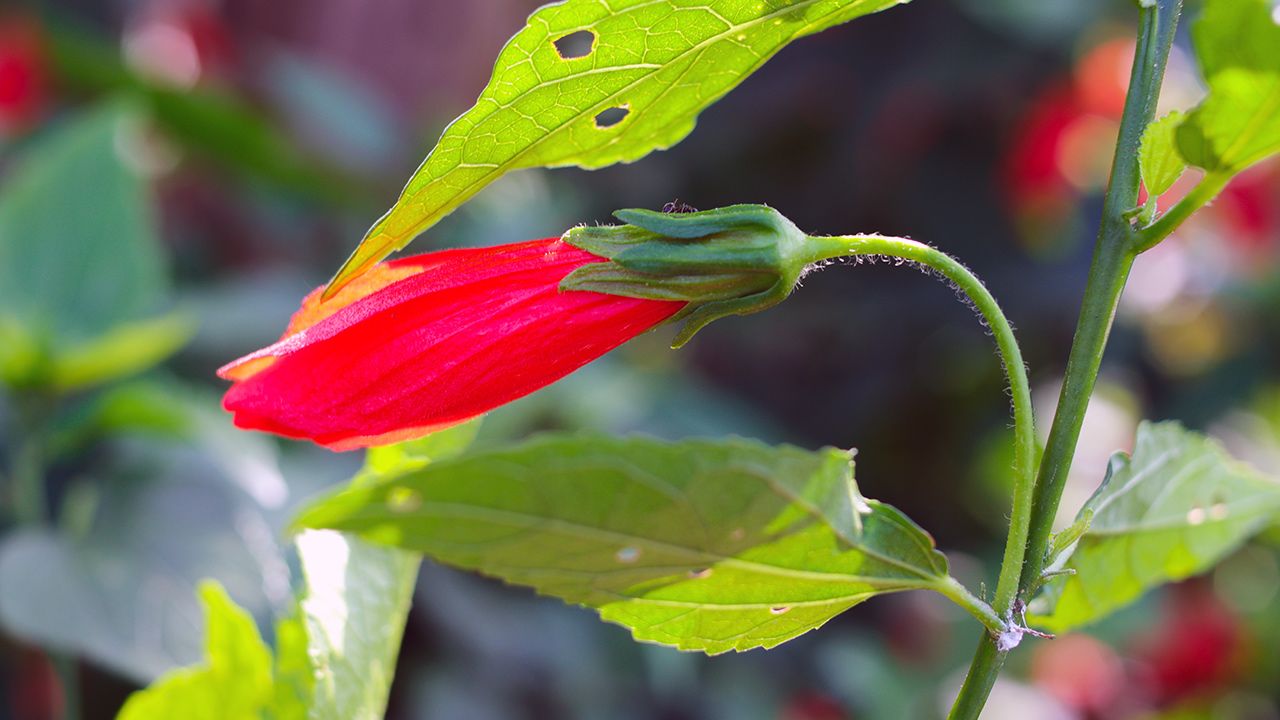
At a Glance:
- Common Names: Lipstick Plant, Lipstick Vine, Basket Vine
- Scientific Name: Aeschynanthus radicans
- Family: Gesneriaceae
- Type: Evergreen Perennial
- Mature Size: Up to 3 feet in length
- Sun Exposure: Prefers bright, filtered light
- Soil Preference: Thrives in well-drained soil
- Soil pH: Neutral to alkaline
- Blooming Season: Spring to Fall
- Flower Color: Radiant red
- Hardiness Zones: USDA zones 10a to 11b, typically nurtured as an indoor plant
- Indigenous Region: Asia
From the rich tropical regions of Southeast Asia comes the captivating lipstick plant, known scientifically as the aeschynanthus species. But what sets this plant apart from the vast array of other indoor plants we could choose to adorn our homes with?
Firstly, the lipstick plant boasts an exquisite array of bright red flowers, strikingly juxtaposed against a lush canvas of dark green leaves. It's these vibrant blooms, reminiscent of the rich hues of classic lipstick, that bestow upon it its evocative name. The allure doesn't end there. As you delve deeper into its origins, you'll discover its significance in tropical plant taxonomy and its esteemed status among plant enthusiasts.
Moreover, beyond its aesthetic appeal, the lipstick plant offers an intriguing journey into plant care. From understanding the nuances of its native habitat to the intricacies of ensuring those iconic flower buds blossom in full glory, the lipstick plant becomes not just a decorative piece, but an engaging hobby. Whether you're a seasoned horticulturist or a budding green thumb, the lipstick plant presents both a challenge and a reward, promising vibrant color and verdant growth with the right care.
Join us as we embark on this exploration, uncovering the secrets of growing and caring for this beautiful specimen, and discovering the unique charm that has made the lipstick plant a favorite among plant lovers worldwide.
Join our newsletter
Stay on top of the latest in landscaping and lawn care with one valuable tip right in your inbox every Saturday morning.
Chapter 1: History and Origin of the Lipstick Plant
The lipstick plant, with its radiant hues and captivating blooms, finds its roots deep within the tropical rainforests of Southeast Asia. Here, amidst the dense green canopies and rich, damp soils, the aeschynanthus species thrived, away from the direct sunlight but bathed in a warm, consistent glow of filtered light.
It's easy to see why this plant was destined for global acclaim. As explorers and botanists traversed the dense jungles of these tropical regions, the mesmerizing bright red flowers of the lipstick plant stood out, demanding attention. It didn't take long for its popularity to surge, and soon, this Southeast Asian gem found its way into households across continents.
Among the myriad of tropical plants, the aeschynanthus species holds a special place. Not just for its vibrant color palette but also for its resilience and adaptability, making it an epitome of beauty and strength in the world of botany.

Chapter 2: Key Characteristics of Lipstick Plants
One of the first things that capture the eye when you encounter a lipstick plant is its dramatic juxtaposition of colors. With striking bright red flowers emerging from what appear to be flower buds shaped like lipstick tubes, it's a visual spectacle that remains unmatched in the botanical world. These radiant flowers are set against a backdrop of lush green leaves, making it an ideal plant for those looking to add a pop of color to their indoor spaces.
But there's more to the lipstick plant than just its primary colors. Now, let's delve into the various types of lipstick plant you can explore for your indoor garden. Over time, as horticulturists and plant enthusiasts engaged with the aeschynanthus species, several varieties made their mark:
- Aeschynanthus Radicans Mona Lisa: Often referred to as the 'Mona Lisa' lipstick plant, this variety is renowned for its glossy, dark green leaves and vibrant red flowers. A true masterpiece in the plant kingdom!
- Twisted Lipstick Plant: As the name suggests, this unique variant stands out for its twisted leaves and, often, a deeper hue of red-orange flowers that give it a distinctive appearance.
- Other Varieties: Beyond the above, there are numerous other varieties, each with its own set of visual features, ranging from different shades of green leaves to varied bloom colors.
Understanding these characteristics and the visual features of different lipstick plant varieties not only aids in identifying them but also allows enthusiasts to choose the perfect plant that aligns with their aesthetic preferences and care capabilities.
Chapter 3: Essential Lipstick Plant Care Techniques
Lipstick plants, with their vibrant bright red flowers and lush green leaves, are undoubtedly a favorite among lipstick plant care indoors enthusiasts. However, for these plants to thrive and exhibit their full beauty, it is essential to follow certain care guidelines. Here's what you need to know:
Light: Bright Light and its Effects on Flower Buds
Lipstick plants thrive best in bright light conditions. While they can withstand some amount of direct sunlight, it's ideal to provide them with bright indirect light. This ensures that their flower buds develop fully and bloom into the signature bright red flowers. Too much direct sunlight can lead to leaf drop, so it's best to strike a balance.
Soil: The Right Potting Soil Mix for Optimal Growth
Potting soil plays a pivotal role in the healthy growth of the lipstick plant. A well-draining potting mix is essential to prevent root rot and other fungal problems. Mixing regular potting soil with some sphagnum moss or perlite can achieve this balance. The soil should remain moist but not waterlogged.

Watering Techniques for Healthy Growth and Vibrant Flowers
The key to watering lipstick plants is consistency. Water the plant thoroughly, ensuring the top few inches of soil become moist. However, it's crucial to ensure the pot has sufficient drainage holes to prevent water from pooling at the bottom. Over-watering can lead to root rot, while under-watering can cause the green leaves to wilt and the bright red flowers to dry.
Temperature and Humidity: Crafting the Perfect Environment
Lipstick plants originate from tropical regions, so they prefer warm and humid conditions. Maintain a consistent room temperature, avoiding sudden temperature changes which can shock the plant. Ensure that the plant isn't placed near heating and cooling vents. A pebble tray filled with water or occasional misting can help maintain high humidity levels conducive for its growth.
Proper lipstick plant care ensures that these unique indoor plants can flourish year-round, presenting their mesmerizing lipstick plant flowers and ensuring a healthy lipstick plant. As with most houseplants, attention to their native habitat and needs will ensure they thrive and become a centerpiece in any room.
Note: Always keep an eye out for signs of stress in your plant, such as yellowing or lipstick plant dropping leaves. Adjust care techniques accordingly to keep your plant healthy and vibrant.
Join our newsletter
Stay ahead of the curve in all things outdoor.
Get the inside scoop on the latest landscaping, lawn care, and fencing trends with 1 actionable tip every Saturday morning.
Chapter 4: Challenges in Lipstick Plant Care and Their Solutions
Lipstick plants, while being a captivating addition to any indoor space, can occasionally face challenges that may hinder their growth and blooming potential. However, with knowledge and timely intervention, these issues can be effectively addressed.
Common Issues: From Root Rot to Leaf Drop
- Root Rot: One of the most prevalent problems faced by lipstick plants, root rot is primarily caused by overwatering. When the potting soil remains waterlogged, it can lead to fungal issues, causing the roots to decay. Regularly check the pot's drainage holes and ensure they're not blocked. If you notice symptoms of root rot, it might be necessary to repot the plant with fresh soil.
- Leaf Drop: This is typically a sign of stress, often due to direct sunlight or sudden temperature changes. Ensure your lipstick plant is positioned in a place with bright indirect light and is shielded from drastic temperature shifts.
Ensuring Flower Buds Bloom Amidst Challenges
Flower buds might not bloom for a variety of reasons, including inadequate light, imbalanced watering, or pests. By addressing the underlying issue—whether it's moving the plant to a brighter spot or adjusting watering routines—you can help ensure those buds turn into the signature bright red flowers.
Solutions for Fungal Problems, Spider Mites, and More
- Fungal Problems: Ensure good airflow around the plant and avoid overhead watering. Using a fungicide can also help in tackling these issues.
- Spider Mites: These tiny pests can be a nuisance, causing the green leaves to have a speckled appearance. Regularly misting the plant and wiping down the leaves can deter spider mites. If the infestation is severe, consider using an insecticidal soap or neem oil solution.
- Leaf Spot: This is usually a sign of fungal or bacterial infection. Removing affected leaves and ensuring proper watering practices can help combat this issue.
Proper care of lipstick plants requires vigilance and responsiveness to the plant's needs. By staying attentive to the signs your plant gives, you can navigate these challenges and ensure a thriving, blooming lipstick plant. Always remember, each plant is unique and might require slight adjustments in care techniques based on its specific environment and health.

Chapter 5: Propagating and Growing Your Lipstick Plants
Growing lipstick plants and ensuring their proliferation in your home can be a joyous experience. With the right techniques, you can easily propagate new plants from your existing ones, leading to a more lush and vibrant indoor garden.
Steps to Ensure New Growth and Healthy Lipstick Plants
- Light: Ensure that your lipstick plants receive bright indirect light, crucial for new growth. A lack of enough light can result in leggy growth and fewer flowers.
- Soil: Use a well-draining potting mix. This ensures the roots have adequate air and prevents issues like root rot.
- Watering: Keep the soil consistently moist, but not waterlogged. Always check the top few inches of the soil before watering.
- Regular Pruning: To stimulate new growth, prune back leggy stems or those that have finished blooming.
From Stem Cuttings to New Plants: A Step-by-Step Guide
- Cutting: Choose a healthy stem from your lipstick plant with at least two to three leaves. Make a cut below a leaf node using sharp, sterilized scissors.
- Preparation: Remove the lower leaves, leaving only the top ones. Optionally, dip the cut end into rooting hormone to boost root development.
- Planting: Plant the cutting into a pot filled with a mix of potting soil and sphagnum moss. Ensure the pot has drainage holes.
- Environment: Place the pot in a location with bright, filtered sunlight and high humidity. A pebble tray or clear plastic bag can help maintain humidity.
- Growth: With consistent moisture and proper care, the stem cuttings will develop roots and start to grow as new plants in a few weeks.
Propagating lipstick plants can be a rewarding endeavor, allowing plant enthusiasts to share the beauty of this unique plant with friends or expand their own indoor garden. By following these steps and ensuring proper lipstick plant care, you'll soon have flourishing new plants to admire and cherish.

Chapter 6: Dive into the Different Lipstick Plant Varieties
The lipstick plant, with its captivating bright red flowers and lush green leaves, has multiple varieties that enthusiasts adore. Each variant brings unique beauty and requires particular care.
Twisted Lipstick Plant
- Appearance: Recognized by its curling leaves and spiraling flower buds. This variety is an elegant sight, especially when the bright red flowers bloom.
- Care Tips: Prefers bright indirect light. Too much direct sunlight may cause leaf drop. Use a well-draining potting soil and keep it consistently moist.
Aeschynanthus Radicans Mona Lisa
- Appearance: Known as the "Mona Lisa" variety, it boasts luscious dark green leaves and vibrant red-orange flowers. It's a popular lipstick plant variety that garners attention.
- Care Tips: This type thrives in high humidity environments. Ensure to place it in a location with bright indirect light. A hanging basket can further accentuate its trailing beauty.
Aeschynanthus Lobbianus
- Appearance: Characterized by its slightly waxy leaves and bright red tubular flowers. It's a sight to behold when in full bloom.
- Care Tips: As with most lipstick plant varieties, it enjoys bright light but not direct sunlight. It also prefers warm and humid conditions similar to its native habitat in Southeast Asia.
Aeschynanthus Japhrolepis
- Appearance: This variety has thicker leaves and its flowers, though not as bright red as other varieties, still offer a captivating sight.
- Care Tips: Adaptable to a range of light conditions, from indirect light to partial shade. Ensure the potting mix remains moist but not soggy to avoid root rot.
To successfully grow lipstick plants of any variety, understanding the unique characteristics of each and tailoring your lipstick plant care techniques is vital. Whether you're drawn to the twisted allure of the Twisted Lipstick Plant or the classic appeal of the Mona Lisa, there's a lipstick plant perfect for every indoor garden. And, with the right care, these tropical plants will continue to mesmerize with their unique flowers year-round.
The Joy of Cultivating Bright Red Flowers in Lipstick Plants
The journey of nurturing a lipstick plant, from the initial potting soil to witnessing the vibrant bloom of flower buds, is undeniably gratifying. These plants, with their lush green leaves and iconic bright red flowers, encapsulate the magic and beauty of nature, right within our homes. Originating from the rich rainforests of Southeast Asia, these tropical beauties have traveled far and wide, capturing the hearts of many plant enthusiasts around the globe.
Embarking on the lipstick plant care journey is not just about adding aesthetic appeal to your space. It's about connecting with nature, understanding the intricacies of plant life, and experiencing the joy of watching something thrive under your care. Every challenge faced, be it root rot or spider mites, only deepens the bond and appreciation for these vibrant beings.
So, as you close this guide, may you feel inspired to embark on your own lipstick plant journey, cherishing every moment from the first sprout to the full bloom of those magnificent red flowers.
Join our newsletter
Stay ahead of the curve in all things outdoor.
Get the inside scoop on the latest landscaping, lawn care, and fencing trends with 1 actionable tip every Saturday morning.